Greater
and Lesser sand plovers
 |
| Greater sand plover (with a Golden plover in the background) PC: Kalirajan Subramanian |
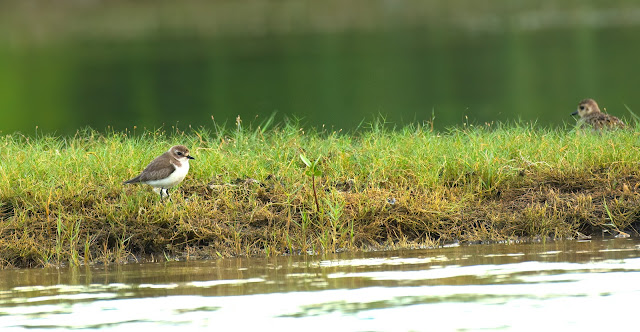 |
| Greater sand plover (with a Golden plover at the far-right background) PC: Kalirajan Subramanian |
 |
| Greater sand plover PC: Kalirajan Subramanian |
 |
| The paler legs of the greater sand plover PC: Kalirajan Subramanian |
The greater (Charadrius
leschenaultii) is a medium-sized plover with a long, hefty bill. Non-breeding
birds and immatures are sandy brown above and white below, with a white throat
and “eyebrows.” Often confused with Lesser Sand-Plover, and best distinguished
when both are present - look for larger size, heavier and longer bill, paler
legs, and larger-headed appearance. Additionally, unlike some Lesser
Sand-Plovers, Greater never has a black boundary around the throat. It breeds
in the semi-deserts of Turkey and eastwards through Central Asia. It nests in a
bare ground scrape.
Distribution: This species is strongly migratory, wintering on sandy beaches in East Africa, South Asia and Australasia.
It is a rare vagrant in western Europe, where it has been recorded as far west
as Iceland.
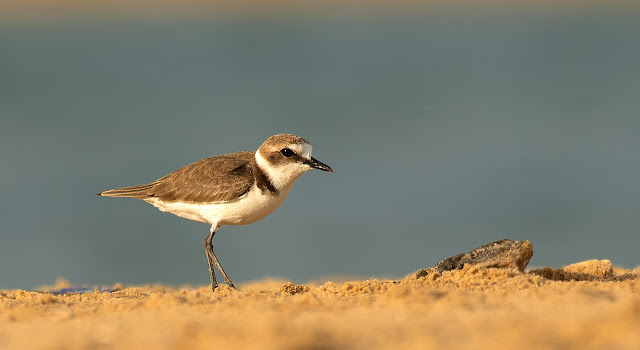 |
| Lesser Sand plover PC: Kalirajan Subramanian |
 |
| Lesser Sand plover PC: Kalirajan Subramanian |
 |
| Lesser Sand plover PC: Kalirajan Subramanian |
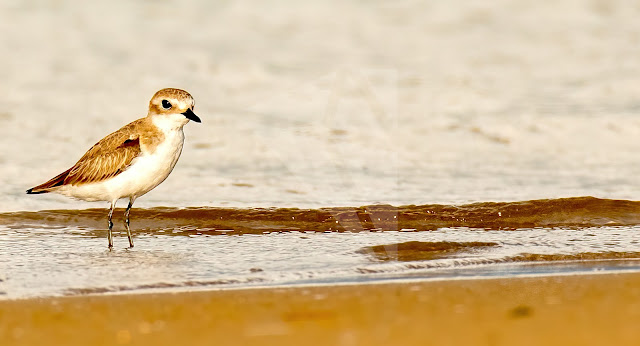 |
| Byte sized beauty PC: Kalirajan Subramanian |
 |
| Boy! Those legs can run PC: Kalirajan Subramanian |
The
lesser sand plover (Charadrius
mongolus) is long-legged and
long billed. Breeding males have grey backs and white underparts. The breast,
forehead and nape are chestnut, and there is a black eye mask. The female is
duller, and winter and juvenile birds lack the chestnut, apart from a hint of
rufous on the head. Legs are dark and the bill black.
 |
| A lesser sand plover enjoying a dip PC: Kalirajan Subramanian |
Distribution: It breeds above the tree line in the
Himalayas and discontinuously across to bare coastal plains in north-eastern
Siberia, with the Mongolian plover in the eastern part of the range; it has
also bred in Alaska. It nests in a bare ground scrape, laying three eggs. This species is strongly migratory, wintering on sandy beaches in east
Africa, south Asia and Australasia. It is a very rare vagrant in western Europe.
 |
| Kentish Plovers with a sandpiper PC: Kalirajan Subramanian |
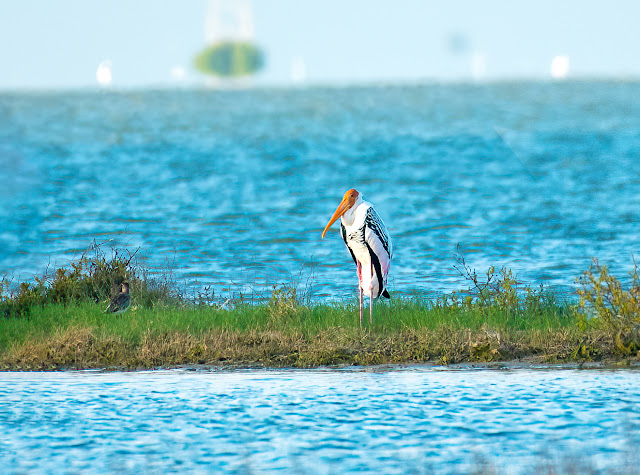 |
| Kentish Plover facing a Painted Stork PC: Kalirajan Subramanian |
Kentish
Plover (Charadrius
alexandrinus) Small, pale plover with broken black collar, sandy upperparts,
grayish legs, and rather fine black bill. Breeding plumage has black mask and
black tabs at sides of breast (not a complete band). Nonbreeding plumages have
black replaced by brown. Mainly coastal, on sandy beaches, dry mudflats, and at
salt ponds, usually near water; also, locally inland. Migrants will join with
flocks of other shorebirds. Its common English name comes from the county of
Kent, where it was once found, but it has not bred in Britain since 1979.
Distribution: Kentish plovers have an extremely wide
geographical distribution and their habitats vary not just spatially but
environmentally too. They are known to reside and breed in multiple types of
habitat, from desert with ground temperatures reaching 50 °C to tundra. The
distribution of this species’ breeding areas covers Europe, Asia and Africa.
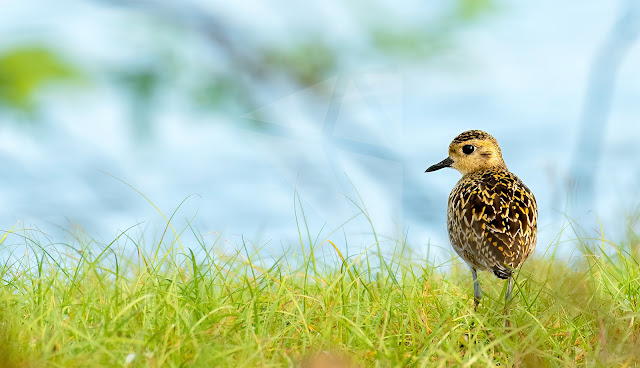 |
| Pacific golden plover (What eyes and patterns!) One of our best lifers PC: Kalirajan Subramanian |
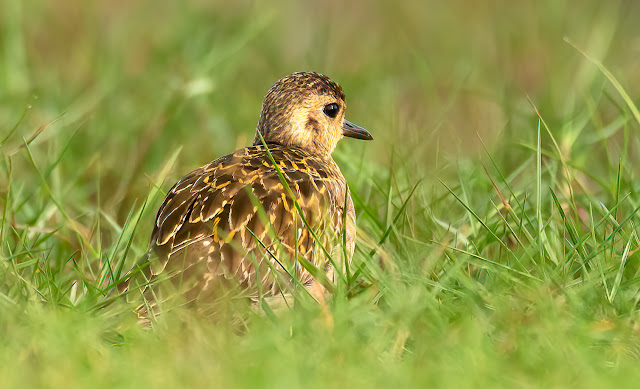 |
| Pacific golden plover PC: Kalirajan Subramanian |
Pacific golden plover (Pluvialis fulva) Slender plover spangled with gold. Breeding plumage shows black belly and face with mottled white sides and undertail coverts and a white stripe down the side of the neck that continues onto the sides of the chest and flanks. Nonbreeding plumage is duller grayish-brown overall with a variable golden wash, often quite bright. At all seasons, note more slender shape, slightly smaller bill, and brighter golden tones than Black-bellied Plover, along with grayish underwing in flight. Extremely similar to American Golden-Plover; Pacific is slightly shorter-winged, longer-legged and larger-billed, but these features are difficult to judge.
Distribution: The Pacific golden plover is migratory, and breeds during May, June, and July in Alaska and Siberia. It migrates south to Asia, Australasia, and Pacific islands in August and September, and stays until April or May. A rare vagrant to western Europe.
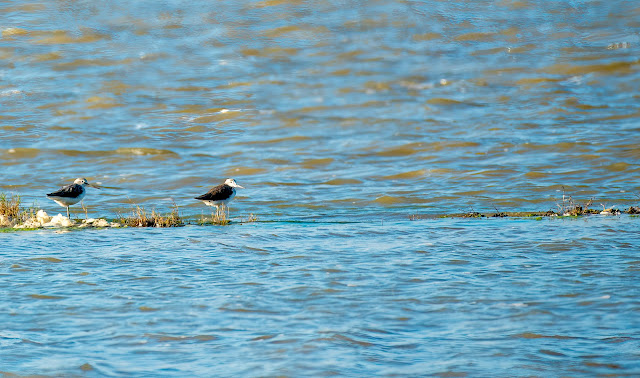 |
| Common sandpipers PC: Kalirajan Subramanian |
Common
sandpiper (Actitis hypoleucos) Small
bicolored sandpiper which often bobs its tail in a distinctively wagtail-like
manner. Plain brown with white underparts; distinguished from bulkier and
rounder-headed Green Sandpiper by a prominent white spur at the shoulder.
Distribution: Found in a variety of wetland
habitats; breeds on stony ground along rivers and lakeshores, with migrants
occurring on muddy and rocky substrates from concrete canal banks to channels
in tidal mudflats.The common sandpiper breeds across most of temperate and subtropical
Europe and Asia, and migrates
to Africa, southern Asia and Australia in winter. The eastern edge of its migration
route passes by Palau in Micronesia, where hundreds of birds may gather for a
stop-over.
 |
| Sanderling with a thick dark medium long bill PC: Kalirajan Subramanian |
 |
| Close-up of a Sanderling PC: Kalirajan Subramanian |
 |
| A foraging Sanderling. Both sanderlings and plovers can be quite fast with their legs PC: Kalirajan Subramanian |
Sanderlings (Calidris alba) are small, plump
sandpipers with a stout bill about the same length as the head. These and other
sandpipers in the genus Calidris are often called “peeps”; Sanderlings are
medium-sized members of this group.
Distribution:
It is a circumpolar Arctic breeder, and
is a long-distance migrant, wintering south to South America,
South Europe, Africa, and Australia. It is highly gregarious in winter,
sometimes forming large flocks on coastal mudflats or sandy beaches. In the
northern winter, it has a nearly cosmopolitan distribution across the world's
marine coasts. It is a complete migrant, travelling between 3,000 to 10,000 km from its breeding grounds to its wintering sites. During the winter and its migration, it is most
commonly found on coastal sandy beaches, but also occurs on tidal sand flats,
mud flats and the shores of lakes and rivers. More infrequently, it may occur
on rocky shores.
 |
| Ruddy turnstone PC: Kalirajan Subramanian |
 |
A pair of Sanderlings and Ruddy turnstones PC: Kalirajan Subramanian
|
Ruddy turnstones (Arenaria interpres) Fairly small, stocky shorebird with short,
chisel-like bill. Breeding plumage is particular striking with bright rusty
upperparts and bold black-and-white pattern on head and neck. Nonbreeding and
juvenile are duller brown but still boldly patterned; note orange legs.
Interesting behavior of flipping over rocks, shells, and other debris to nab
invertebrates.Usually in small flocks, often mixed with other shorebirds.
Listen for low, hard rattle call.
Distribution:
Breeds in the high Arctic tundra;
winters on coastlines nearly worldwide. Prefers rocky habitats, but also seen
on beaches and mudflats. In Asia, it is widespread in the south with birds
wintering as far north as southern China and Japan. It occurs south to Tasmania
and New Zealand and is present on many Pacific islands. Some non-breeding birds
remain year-round in many parts of the wintering range, with some of those
birds still taking on breeding plumage in the spring and summer.
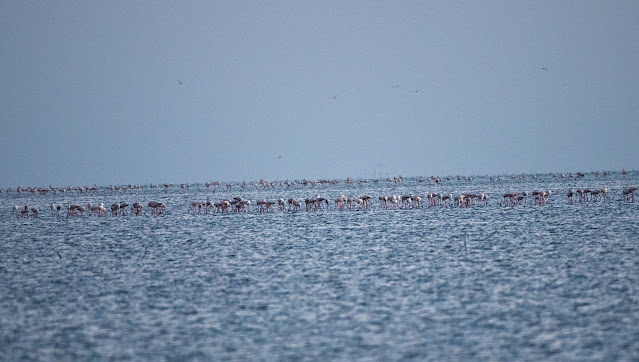 |
| A sizeable flock of Greater flamingos seen from a long-distance PC: Kalirajan Subramanian |
Greater
flamingos (Phoenicopterus
roseus) This species was the reason behind our visit to Pulicat. It was
December, two months already into the annual Oct-March migration season. So,
when Chennai came calling, we decided to club Pulicat into the agenda, luck
favoring we could catch a glimpse of these long-legged, long-necked beauties!
Thanks to forums like Chennai
Bird watchers ,
we got timely information from genuine birders. It was during our self-drive
through SHAR road. We both were stressing our eyes and lenses scanning through
the length of the road and the breadth of the water on both its sides, ID-ing
every single or congregation of birds we could see. At one point, the landscape
got so scenic with fishing nets, boats, the sun & clouds painting stunning
visuals we got immersed in the scenes than in birding. It was then that the
binoculars showed a significant vertical patch of dull greyish-pinkish-white blurry
figures at a significant distance behind the fishermen. Honestly, it took our
breath away that moment! We trained our eyes and the focal lengths again and
with all the concentration we could summon we observed in astute silence. The
hazy, blurry vision was a significant congregation of greater flamingos! Oh,
those slender necks, kinked beaks and endless legs moving on the shallow waters
far away, much beyond clear-view were more than good enough to make our visit.
They were still in their non-breeding plumage, nevertheless sassy.
 |
| Silhouette of the Greater flamingo flock PC: Kalirajan Subramanian |
The greater flamingo
resides in mudflats and shallow coastal lagoons with salt water. Using its
feet, the bird stirs up the mud, then sucks water through its bill and filters
out small shrimp, seeds, blue-green algae, microscopic organisms, and mollusks.
The greater flamingo feeds with its head down, and its upper jaw is movable and
not rigidly fixed to its skull. Like all flamingos, this type of species lays a
single chalky-white egg on a mud mound.
Distribution:
They are found in parts of Africa,
southern Asia (Bangladesh and coastal regions of Pakistan, India, and Sri
Lanka), the Middle East and southern Europe. The most northern breeding spot is
the Zwillbrocker Venn in western Germany, close to the border with the
Netherlands. They have been recorded breeding in the United Arab Emirates at
three different locations in the Abu Dhabi Emirate. In Gujarat, flamingos can
be observed at the Nal Sarovar Bird Sanctuary, Khijadiya Bird Sanctuary,
Flamingo City, and in the Thol Bird Sanctuary. They remain there during the
entire winter season. We also came to know that during the peak breeding months
they can be seen in large numbers all around the Pulicat lake and in other
places also like Sholinganallur marsh land
 |
| Black-tailed Godwits PC: Kalirajan Subramanian |
 |
| Flock of Black-tailed Godwits landing on water PC: Kalirajan Subramanian |
Black tailed godwits (Limosa limosa) Gregarious medium-sized wader with a long, slightly uptilted bill. Note the very long, pink-based bill. Breeding plumage has bright rusty head and breast, dark barring on belly; nonbreeding plumage has rather plain grayish head, breast, and upperparts. They are also a “Near Threatened(NT)” species as classified by the International Union for Conservation of Nature(IUCN) as that may be vulnerable to endangerment in the near future.
Distribution:
Its breeding range stretches from
Iceland through Europe and areas of central Asia. Black-tailed godwits spend
(the northern hemisphere) winter in areas as diverse as the Indian
subcontinent, Australia, New Zealand, western Europe and west Africa. The
species breeds in fens, lake edges, damp meadows, moorlands and bogs and uses
estuaries, swamps and floods in (the northern hemisphere) winter; it is more
likely to be found inland and on freshwater than the similar bar-tailed godwit.
The black-tailed godwit is the national bird of the Netherlands.
 |
| A dash of grey above the blue PC: Kalirajan Subramanian |
 |
| A flock of four grey herons PC: Kalirajan Subramanian |
Grey
Heron (Ardea cinerea) Generally quite common and conspicuous in
wetland habitats from marshes and tidal flats to small ponds, ditches, and wet
fields; nests colonially in tall trees. Mainly seen as singles or in small groups,
standing quietly in or at the edge of water, less often hunting in fields.
Plumage mostly gray overall, with paler neck; adult has white crown, black
eyebrows, and black shoulder patch. Like other herons and egrets, flies with
neck pulled in to form a bulge.
Distribution:
Has an extensive range of presence but
mostly a resident species in its range
Gulls
and Terns
 |
| A congregation of L-R brown headed gulls, lesser crested terns, greater crested terns, caspian terns and brown headed gulls again PC: Kalirajan Subramanian |
 |
| A first-year Pallas's gull PC: Kalirajan Subramanian |
 |
| A non-breeding Pallas's gull PC: Kalirajan Subramanian |
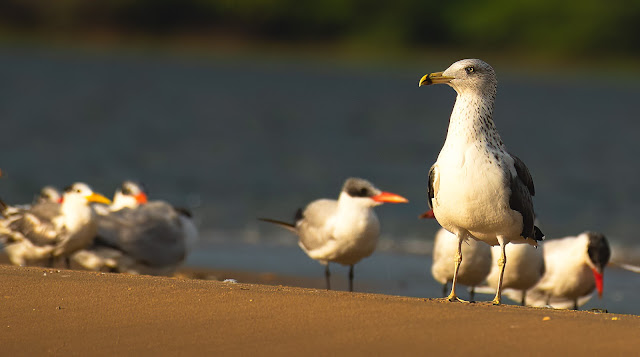 |
| A pensive first-year Pallas's gull against the golden sun PC: Kalirajan Subramanian |
 |
| Pallas's gull posing like a model PC: Kalirajan Subramanian |
Pallas'
gull (Ichthyaetus ichthyaetus) - Large
powerful gull of saline, brackish, and freshwater bodies. Breeding adult has a
black head with a thin incomplete crescent around the eye and a
red-and-black-tipped bill. Nonbreeding adults retain a partial “hood” of patchy
black on the back of the head. Young birds also have this dark patch, though it
is much smaller in size. Can be readily separated by size in any plumage from
the smaller dark-headed gulls. This gull nests on the ground, laying between two
and four eggs.
 |
| Another non-breeding adult from the Pallas's gull flock PC: Kalirajan Subramanian |
Distribution:
This species breeds in colonies in
marshes and islands from southern Russia to Mongolia. It is migratory, wintering in the eastern
Mediterranean, Arabia and India. The species also occurs as a vagrant in
differing parts of the Indian Ocean, south of its normal range, and along the
northern and eastern coasts of Africa, where it visits annually on an irregular
basis.
 |
| Three non-breeding adult Brown headed gulls PC: Kalirajan Subramanian |
Brown
headed gull (Chroicocephalus
brunnicephalus) The pale button eyes of this gull give it a somewhat fearsome
appearance. Breeding adult’s head is the color of milk chocolate, lightening
towards the bill. Non-breeding and first-winter birds have a dark ear patch and
faint traces of the dark hood. All plumages may be confused with smaller
Black-headed Gull but note pale eyes and more extensive black on the primaries
in all plumages. This is a bold and opportunist feeder, which will scavenge in
towns or take invertebrates in ploughed fields with equal relish.This is a
noisy species, especially at colonies.
 |
| Last three birds on the left with orange-red legs are brown headed gulls. The other 3 bigger birds with orange bills with black tip are Caspian terns. The smaller one in the right-front with yellow beak and a black crest behind the head is the lesser crested tern PC: Kalirajan Subramanian |
Distribution:
This is a small gull which breeds in
the high plateaus of central Asia from Tajikistan to Ordos in Inner Mongolia. It is migratory, wintering on the coasts and large
inland lakes of the Indian Subcontinent.
 |
| A lesser crested tern in flight PC: Kalirajan Subramanian |
 |
| The smaller flying bird with yellow beak is lesser crested tern. The other one is a caspian tern PC: Kalirajan Subramanian |
Lesser
crested terns (Thalasseus
bengalensis) Elegant medium-sized tern with a slender yellow-orange bill and
black crown. Can be confused with Great Crested Tern; note proportionally
longer, more orangey bill on Lesser Crested. Also note gray upperwing, which
separates it from Sandwich Tern. Gray rump and tail are diagnostic if seen
well. Call a noisy “kerrrick.” The genus name is from Ancient Greek Thalasseus,
"fisherman" from thalassa, "sea". The specific bengalensis
means "of Bengal", the type locality, historically referring to much
of northern India and Bangladesh.
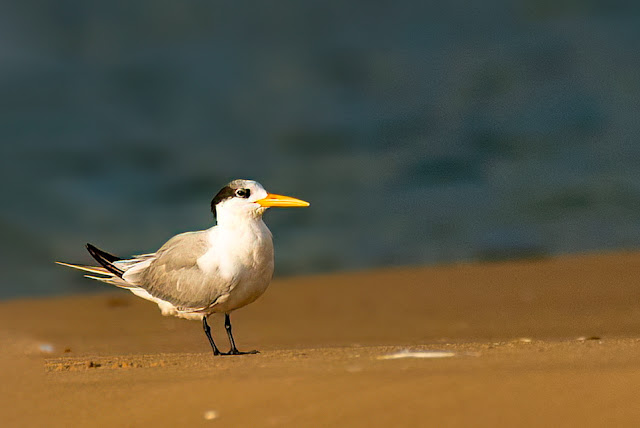 |
| Closeup of a lesser crested tern PC: Kalirajan Subramanian |
 |
| A lesser crested tern with a non-breeding Caspian tern. A brown headed gull in the background PC: Kalirajan Subramanian |
Distribution:
Lesser crested tern breeds in subtropical coastal parts
of the world mainly from the Red Sea across the Indian Ocean to the western
Pacific, and Australia, with a significant population on the southern coast of
the Mediterranean on two islands off the Libyan coast. The Australian birds are
probably sedentary, but other populations are migratory, wintering south to
South Africa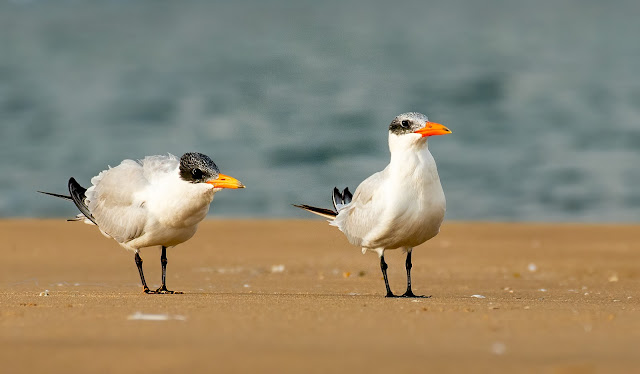 |
| A Caspian tern juvenile(left) with a non-breeding adult Caspian tern PC: Kalirajan Subramanian |
Caspian
terns (Hydroprogne caspia)
Largest tern in the world; widespread but typically uncommon. Thick, bright-red
bill is distinctive; most have small dark marking near the tip. Note solid
black cap in summer which turns to black streaks in winter. Juveniles have
V-shaped markings on the upperparts. Feeds by cruising over lakes, rivers,
estuaries, and reservoirs looking for fish, then plunging to catch them. Smooth
wingbeats, more gull-like than choppy flight of small-bodied terns. Very vocal,
giving loud raucous screams.The Caspian tern is one of the species to which the
Agreement on the Conservation of African-Eurasian Migratory Waterbirds (AEWA)
applies
 |
| Caspian terns in flight PC: Kalirajan Subramanian |
 |
| The bright orange-red streak of Caspian tern in flight PC: Kalirajan Subramanian |
Distribution:
Their breeding habitat is large lakes
and ocean coasts in North America and locally in Europe, Asia, Africa, and
Australasia. European and Asian birds spend the non-breeding season in the Old
World (Afro-Eurasian) tropics. African and Australasian birds are resident or
disperse over short distances.
 |
| Eurasian Curlew PC: Kalirajan Subramanian |
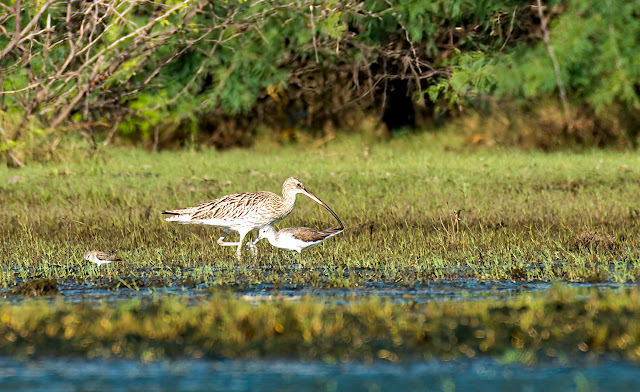 |
| Eurasian Curlew with a Common greenshank below its beak and a lesser sand plover behind it in the left PC: Kalirajan Subramanian |
Eurasian
curlew (Numenius arquata)
Scimitar-billed large shorebird of varied open habitats. Note large size,
overall brown plumage, and long, decurved bill (appreciably shorter on
juvenile). In flight shows white back patch, mostly white underwings. Common
call an onomatopoeic "coor-lee." Breeds mainly in grasslands, from
coastal marshes to upland moors; winters mainly in coastal lowlands, especially
mudflats and adjacent marshes.
 |
| Eurasian Curlew taking off PC: Kalirajan Subramanian |
Distribution:
The curlew exists as a migratory species over
most of its range, wintering in Africa, southern Europe and south Asia. It is
present all year in the milder climates of Ireland and the United Kingdom and
its adjacent European coasts.
 |
| United they stand...stand ...and stand! Black winged stilts PC: Kalirajan Subramanian |
 |
| Single leg statues Black winged stilts on one leg (often waders stand on one leg to conserve energy) PC: Kalirajan Subramanian |
Black-winged
stilts (Himantopus himantopus)
Striking large black-and-white wader with a thin, straight bill and bright pink
legs, found in wetlands with open shallow water throughout much of Africa and
Eurasia, often in brackish habitats.
Often forms noisy colonies on bare ground near water. Feeds by wading in
water, picking from the water surface with its needle-like bill. In flight,
long pink legs stick out far beyond the tail. Calls loudly and stridently,
especially when alarmed during the breeding season.
 |
| Black winged stilt closeup wing open PC: Kalirajan Subramanian |
Distribution:
The breeding habitat of all these
stilts is marshes, shallow lakes and ponds. Some populations are migratory and
move to the ocean coasts in winter; those in warmer regions are generally
resident or short-range vagrants.
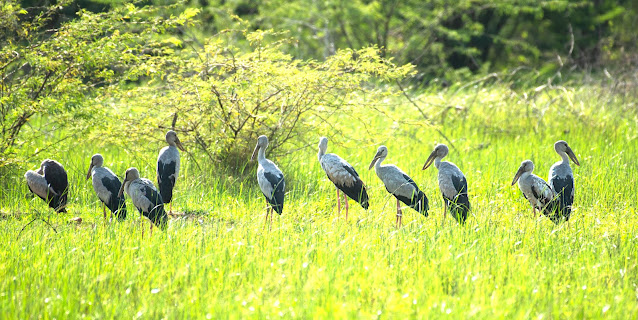 |
| A congregation of Asian openbills in a field outside the lake PC: Kalirajan Subramanian |
Asian
openbills (Anastomus oscitans) A
relatively small stork species with a grayish to white body and black wings and
tail with a hint of gloss. The Asian Openbill gets its name from a distinctive
gap in the dull grayish yellow bill. Note the pinkish legs. Asian Openbills
inhabit wetland habitats including shallow marshes, flooded agricultural
fields, and lakes. From a distance they could be confused with herons, but they
can be clearly distinguished from herons by their feeding habits—wading slowly
through shallow water. Soars frequently, often in large dense flocks; note
extended neck, unlike retracted neck of herons and egrets.
Distribution:
They may move widely in response to
habitat conditions. Individuals ringed at Bharatpur in India have been
recovered 800 km east and a bird ringed in Thailand has been recovered 1500 km
west in Bangladesh. Storks are regularly disoriented by lighthouses along the
southeast coast of India on overcast nights between August and September. The
species is very rare in the Sind and Punjab regions of Pakistan, but widespread
and common in India, Sri Lanka, Nepal, Bangladesh, Myanmar, Thailand and
Cambodia. It has recently expanded its range into southwestern China.
Threats to Pulicat lake ecosystem
This beautiful brackish water ecosystem encounters multiple threats due to anthropogenic influence. Climate change, lack of dredging, mixing of sewage, chemical waste, pesticides from the surrounding industrial and agricultural areas are huge threats to the flora and fauna inhabiting the lake. This in turn heavily impacts fishing and the livelihood of the locals.
The Pulicat Lake ecosystem is degraded by siltation, bar mouth dynamics, shell mining and processing, worm poaching and population pressure due to the resettlement of villagers from Sriharikota Island. It has been determined that the extent of the lake, including its water spread area, is decreasing. Many waterlogged muddy areas of mangrove habitat are now transformed to vast arid areas which are dominated by invasive plant species.
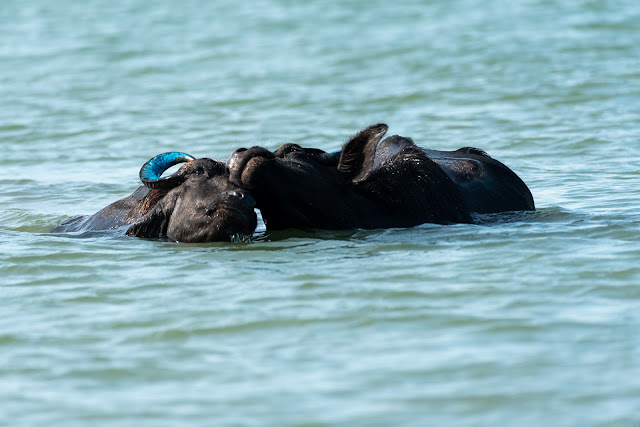 |
| Ye dosti! Two Bos Bubalis dudes claiming their stake to the water body PC: Kalirajan Subramanian |
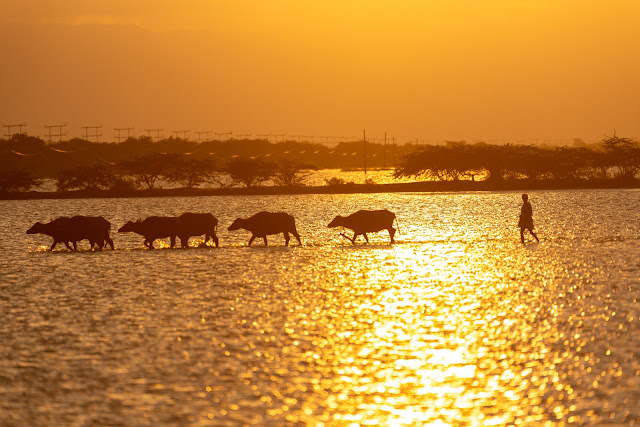 |
| The degradation of the lake will have serious impact on the flora, fauna and humans who depend on the lake's natural bounty for their livelihood PC: Kalirajan Subramanian |
 |
| Another mesmerizing moment with the natural elements. The lake is a treasure trove for landscape photography too PC: Kalirajan Subramanian |
“Binoculars, and a hawk-like vigilance, reduce the disadvantage of myopic human vision.”
― J. A. Baker, The
Peregrine
References: Wikipedia,
ebird, All about birds (Cornell Lab), Researchgate, Mongobay









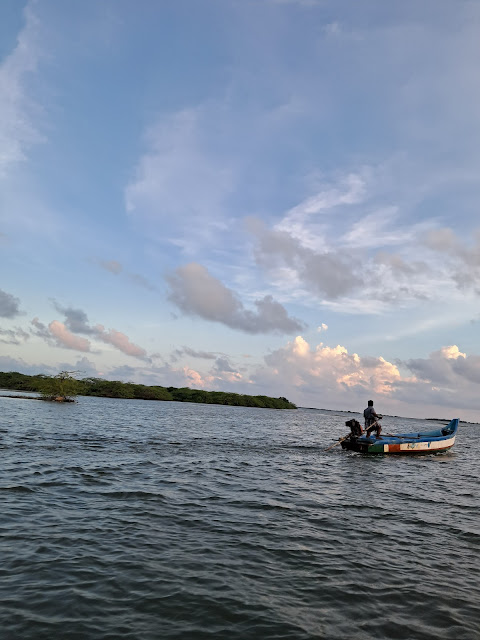

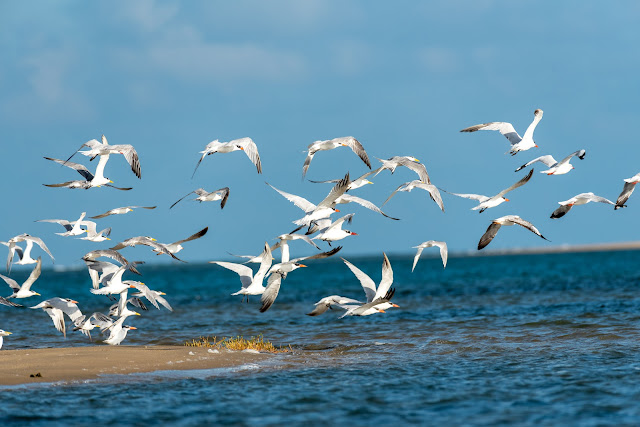

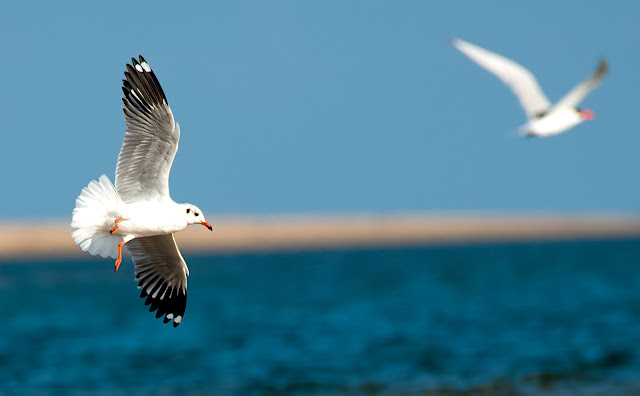

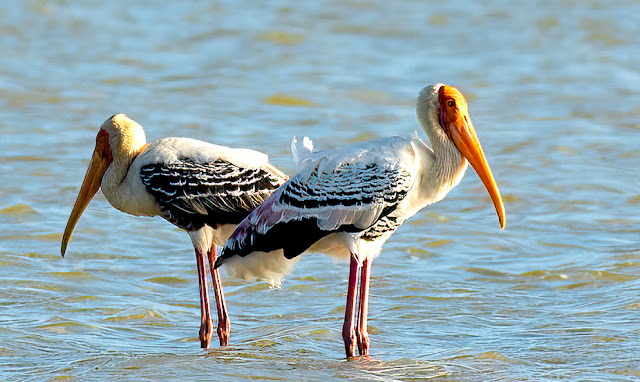



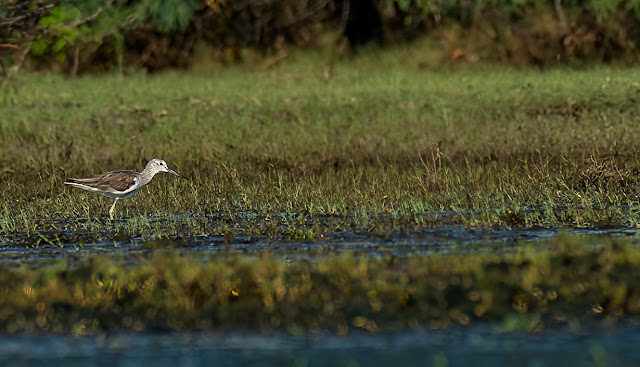
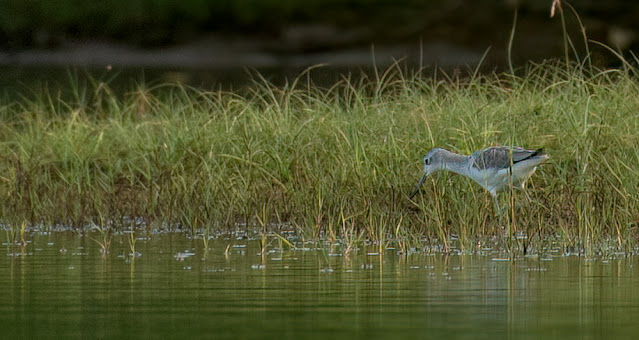


















































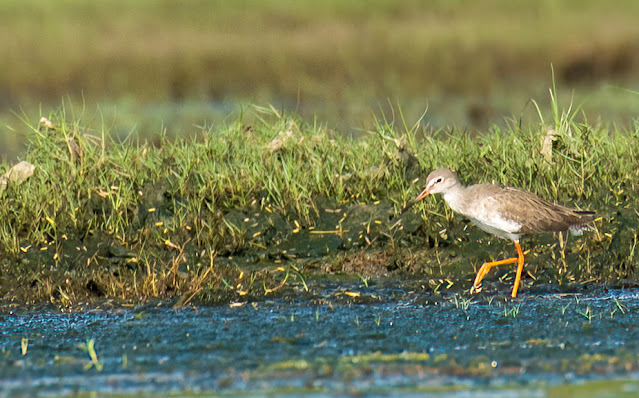

Comments